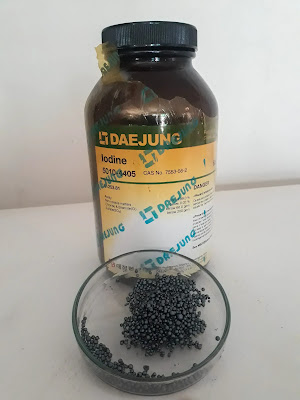Contents
hide
CHEMICAL PRODUCT IDENTIFICATION
- Product Namely: Iodine.
- Signal Word: Warning!
- Read about power of purity – Iodine SDS!
The chemical element iodine is a solid that is purple-black and glossy when it is at normal temperature. It is frequently used as an antiseptic, disinfectant, & in the synthesis of thyroid hormones.
HAZARDS IDENTIFICATION
- Acute toxicity, dermal, and inhalation hazards.
- damaging(harmful) if breathed in or comes into contact with skin.
COMPOSITION, INFORMATION ON INGREDIENTS
- Name of Component: Iodine.
- CAS Number: 7553-56-2.
- Formula: I₂.
- Formula(molar) Wt.: 253.81 /mol.
FIRST-AID MEASURES
- If you feel unwell, contact a doctor.
- If inhaled: Remove the victim to fresh air & keep them at rest in a breathing-friendly position.
- If in the eyes: Carefully rinse for a few minutes(20 minutes) with water. If contact lenses are present & simply possible to remove, do so. Rinsing continues.
- If on the Skin: Use lots of water for washing.
- If Swallowed: Rinse your mouth. If you feel sick, make a doctor’s appointment.
- Wash contaminated clothes before reusing them.
FIRE-FIGHTING MEASURES
- It appears as solid that doesn’t catch fire.
- Produces dangerous gases when heated.
- Use a tri-class dry chemical fire extinguisher in the event of a fire (Use carbon dioxide, foam, dry chemical, or water spray).
- Flash Point: Not applicable.
- Autoignition Temperature: Not applicable.
- Flammability: Not applicable.
- Explosion Hazards: Not applicable.
- Fire-Extinguishing Agents: Not applicable.
ACCIDENTAL RELEASE MEASURES
- Clean up, put in a sealed bag or container, & throw away (Dispose of).
- After the debris has been collected, ventilate the area & clean the spill site.
HANDLING & STORAGE
- Store alongside phosphates, sulphates, sulfites, acetates, & halides.
- Keep it in a Lab’s chemical safety bag.
- Store in a dry, cold environment away from heat & sources of ignition. frequently oxidises metal containers or shelves that are close to the iodine.
- Avoid breathing in dust or odours.
- Keep away from strong acids & oxidizing agents.
- Use only in a well-ventilated room or under a hood.
EXPOSURE CONTROLS, PERSONAL PROTECTION
- Wear appropriate eye protection, gloves, & clothes.
- After handling, carefully wash your hands.
- Use only under a hood or in a room with good ventilation.
- recommendations for exposure OSHA’s limit is 0.1 ppm, while the TLV for inhalable fraction & vapour is 0.01 ppm (ACGIH) Ceiling REL-0.1 ppm (NIOSH).
PHYSICAL & CHEMICAL PROPERTIES
- Symbol: I.
- Appearance: solid, dark-grey or purple-black, non-metallic, & lustrous.
- Solubility: It is not very soluble(insoluble) in water & it is soluble in organic solvents like ethanol or methanol.
- Stability: It is stable under normal conditions.
- Boiling point: 184.4°C
- Melting point: 113.5°C
- Specific gravity: 4.93 g/cm3.
- Vapor pressure: 0.3 mm Hg.
- Vapor density: 8.8.
STABILITY & REACTIVITY
- It has a fair shelf life.
- Reacts aggressively with incompatible substances such as metal powders, antimony, ammonia, acetaldehyde, and acetylene, creating a fire & explosive risk.
- Steel is corroded by it.
TOXICOLOGICAL INFORMATION
- Acute effects: It causes high levels of toxicity, dangerous vapour, corrosiveness, severe lachrymation, sensitizer, nausea, & vomiting issues.
- Chronic effects: It causes skin irritation(Dermatitis).
- Target organs: It targeted to Thyroid.
- LD50 for ORL-HUM: 28 mg/kg.
- LC50 for IHL-RAT: N/A.
- LD50 for SKN-RBT: N/A.
ECOLOGICAL INFORMATION
- Iodine may pose environmental risks, particularly to fish.
- Iodine in the air can settle into water or soils after combining with water molecules. When iodine is present in the soil, it will bond with organic matter & stay this way for a very long time, Such soils may allow iodine to be absorbed by plants.
DISPOSAL CONSIDERATIONS
- Dispose of in accordance with local, state, & federal rules or laws.
TRANSPORT INFORMATION
- Iodine is its shipping name. U.N. code: UN3495 Risk level(hazard-class): 8 (6.1).
REGULATORY INFORMATION
- RCRA code D002, TSCA listing (231-442-4), & EINECS listing.
OTHER INFORMATION
This Iodine SDS is intended as a piece of advice & is based on data & tests that are likely to be reliable. I don’t guarantee the data’s correctness or completeness & I’m not responsible for any resulting losses. The information is only being provided for your review, research, & verification. I DO NOT ASSUME RESPONSIBILITY AND EXPRESSLY DISCLAIM LIABILITY FOR LOSS, DAMAGE, OR EXPENSE RESULTING FROM OR IN ANY WAY CONNECTED WITH THE HANDLING, STORAGE, USE, OR DISPOSAL OF THIS PRODUCT FOR THE FOREGOING AND OTHER REASONS.

CONCLUSION
Read Iodine SDS before handling, Iodine is a chemical element that is used for a variety of purposes, most notably as an antiseptic & disinfectant. Although it is regarded as a generally safe drug, it must be handled & stored properly to avoid accidents & reduce any potential health risks. Iodine should be handled carefully & proper safety precautions should be taken because ingesting large amounts of it can be dangerous. If you think you may have been exposed to iodine, seek aid right away.
